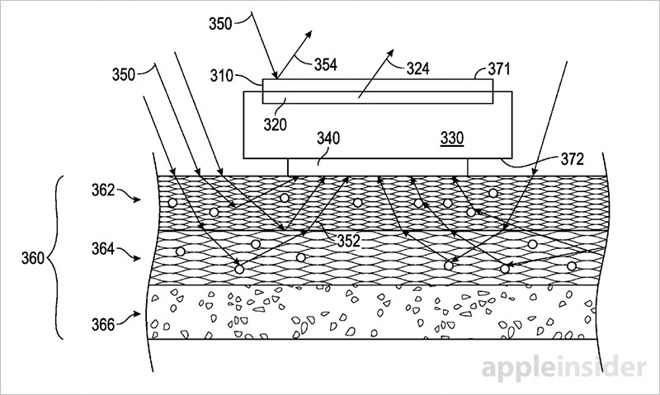Smartwatches perhaps more than any other portable device would benefit from power saving and color adjustable displays, but squeezing the requisite ambient light sensor that serves as the basis of such technology into an already stuffed chassis is a difficult proposition. Apple might have solved the problem, however, with a sensor capable of detecting light reflected through flesh.
In a patent application titled Ambient light sensing through the human body published by the U.S. Patent and Trademark Office on Thursday, Apple notes traditional ambient light sensing technology relies on sensors embedded beneath a front-facing display. Indeed, Apple's own iPhone and iPad use ALS modules hidden in their bezels.
Compared to phones and tablets, smartwatch devices like Apple Watch are severely constrained when it comes to extra internal space. Apple Watch in particular is bristling with audio and optical sensing equipment, including a large heart rate sensor-cum-inductive charging unit in its undercarriage. Further, Apple Watch is tight on space on its display side due to the large OLED display.
Instead of adding another — unaesthetic — sensor window to its sleek wearable, Apple proposes installing an ALS mounted on the underside of Apple Watch's chassis. Aside from looking good, the position should also cut down on errant measurements from the odd stray shirt cuff or bit of grime.
Apple suggests "the human body, or more particularly, the skin and flesh of the human body can become an interface between incident light and the optical sensor." More specifically, incident light entering the skin and flesh is reflected back out towards a waiting optical sensor, where it is converted into a measurable current or voltage.

In certain embodiments, the system is tuned to compensate for attenuation of light through the skin, and different types of skin, using physical filters and software. Apple notes software solutions can be adaptive, or dynamically tunable based on previously capture results or via manual configuration.
In other embodiments, the sensor is capable of detecting a wide variety of light sources and lighting environments, data that can then be used to adjust the onboard display to more accurately reproduce onscreen colors. Apple already ships a version of adjustable color technology in its True Tone display, introduced with the 9.7-inch iPad Pro.
As an added bonus, the ALS module might also be configured to detect and alert users to harmful UV light dependent on levels of exposure, a useful feature for outdoorsy types. Other implementations include integration with various onboard sensors like GPS radios, accelerometers and information stored in installed apps. In one example, a lack of light and motion data from the ALS and accelerometer might be used to determine that a user is sleeping, thereby prompting Apple Watch to enter a power saving mode.
It is unclear if Apple intends to incorporate advanced ALS sensor functionality into Apple Watch, though technology from the company's mobile devices are constantly trickling down into other product lines. As an example, iPhone's 3D Touch is an enhanced version of Force Touch and Taptic Engine technology first introduced with Apple Watch. Most recently, Apple Watch Series 2 borrowed assisted GPS technology from iPhone and iPad.

No comments :
Post a Comment